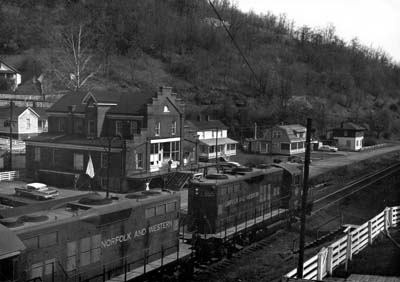"Mary, come home!" My Trip Back to Wenonah
By Mary Catherine Bones

The N&W ran through the heart of Wenonah. The large brick building is the company store, ca. 1957.
It was many years before I could return to my childhood home of Wenonah—a small town in Mercer County about five miles north of Matoaka.
The many years stretched out a bit longer when I missed the turn off Route 10 onto the one-lane road leading to my birthplace. My first familiar sight was the red coneflowers, still blooming near that long flight of steps leading to G. C. Tabors’ backdoor. For three years, I would climb those steps weekly to get piano lessons from Rosala Tabor on her mother’s baby grand. Afterwards, I’d sit in the kitchen with Mrs. Tabor, chat, and warm my boots before walking back home in the cold.
The road to Wenonah is about five miles long, ending at the mine portal. Above that entrance, a never-paved road leads to Elgeria and Flat Top Mountain, which overlays a vein of bituminous coal. The mine was owned by Turkey Gap Coal and Coke and operated by James Anthony McQuail (1881-1955). Turkey Gap was licensed to ship coal in 1898.
“Captain” David Harvey Barger of Shawsville, Virginia, supposedly built the houses and company store at Wenonah. He earned his title while serving as conductor on the Norfolk and Western (N&W) Railway. According to former state archivist Kyle McCormick, Barger was the “conductor in charge” on the first N&W passenger train into the Pocahontas Coalfield in 1883. Captain Barger (1857-1931) retired from the N&W in 1905 and became a wealthy railroad and coal developer in the region. He also served as president of the Bank of Matoaka, and Barger Street in Matoaka was named for him. Walnut Grove, his retirement estate in Shawsville, is now a popular tourist attraction.
While we always knew our town as Wenonah, the post office was officially called Dott to avoid confusion with the town of Winona in Fayette County. Dott was chosen because it was the nickname of Captain Barger’s daughter Dorothy.
When I reached the widest place in the road, I parked my car. My friend who rode with me alighted onto the ground where the company store once stood and exclaimed loudly, “Where is it? Where are the houses, the store, the post office? I thought we were going to see your birthplace?”
He looked north, east, west, and south. Everything was covered with tall trees and brush weeds, with a few flowers blooming. I pointed out two evergreens, at least 20-feet high, that my mother had planted in our front yard, standing as a monument to our beloved home.
We walked across Wenonah’s only bridge, over Widemouth Creek, then turned left up a short hill and over some cinders where the railroad tracks had been removed. My friend surged through the brush to my birthplace.
He discovered a red brick and insisted I keep it—one of the last remnants from my house. A small stream flowed over huge rocks to the north of our house. It wasn’t the season for those long-stemmed violets I loved to gather for my mother. I was enthralled to be there again.
My friend, who’d seen my brother’s photos of Wenonah, tried to imagine how the town used to look. To this day, it’s still mind-boggling that so many houses were perched on those steep hillsides. We drove on to the mine portal, where No Trespassing signs reminded us that we weren’t allowed or wanted there. We drove away quickly, stopping only to pick up a large chunk of coal as a keepsake.
You can read the rest of this article in this issue of Goldenseal, available in bookstores, libraries or direct from Goldenseal.